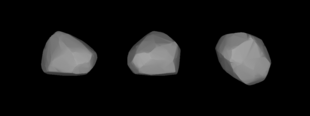(5) Astraea
|
Asteroid (5) Astraea |
|
|---|---|

|
|
| Model of the shape of the asteroid | |
| Properties of the orbit ( animation ) | |
| Orbit type | Main belt asteroid |
| Asteroid family | Astraea family |
| Major semi-axis | 2.577 AU |
| eccentricity | 0.19 |
| Perihelion - aphelion | 2.086 AU - 3.068 AU |
| Inclination of the orbit plane | 5.4 ° |
| Length of the ascending node | 141.6 ° |
| Argument of the periapsis | 358.4 ° |
| Time of passage of the perihelion | December 12, 2011 |
| Sidereal period of rotation | 4 a 47 d |
| Mean orbital velocity | 18.42 km / s |
| Physical Properties | |
| Medium diameter | 117 km |
| Dimensions | ≈ 1.8 · 10 18 kg |
| Albedo | 0.23 |
| Medium density | ≈ 2.1 g / cm³ |
| Rotation period | 16.8 h |
| Absolute brightness | 6.9 likes |
|
Spectral class (according to Tholen) |
S. |
|
Spectral class (according to SMASSII) |
S. |
| history | |
| Explorer | Karl Ludwig Hencke |
| Date of discovery | December 8, 1845 |
| Source: Unless otherwise stated, the data comes from JPL Small-Body Database Browser . The affiliation to an asteroid family is automatically determined from the AstDyS-2 database . Please also note the note on asteroid items. | |
(5) Astraea (originally (5) Asträa ) is an asteroid in the main asteroid belt , an asteroid field between Mars and Jupiter . The asteroid was discovered by Karl Ludwig Hencke on December 8, 1845 .
The celestial body was named after Astraea , a daughter of Zeus and goddess of justice.
After the first four asteroids (1) Ceres , (2) Pallas , (3) Juno and (4) Vesta were discovered in the years 1801–1807 , it took 38 years for the fifth asteroid to be discovered. It was also the last asteroid discovery, prior to the discovery of the planet Neptune . Since at that time the asteroids were still counted as full-fledged planets, Neptune, discovered in the following year, was counted as the thirteenth planet.
With the discovery of (6) Hebe in 1847, however, a veritable flood of new asteroid discoveries began. Therefore, at the suggestion of Alexander von Humboldt in 1851, the number of (large) planets was limited to eight and the new concept of asteroids (also: planetoids or minor planets ) was introduced.
Astraea will move around the sun in 4.1 years and at a distance of 2.1 ( perihelion ) to 3.1 ( aphelion ) astronomical units . The orbit is inclined 5.4 ° to the ecliptic , the orbit eccentricity is 0.19.
Astraea has a diameter of 117 km. The asteroid has a relatively bright, silicate-rich surface with an albedo of 0.23. During opposition , Astraea reaches a brightness of 11.9 mag . It rotates around its own axis in 16.8 hours.
See also
Web links
Individual evidence
- ↑ JF Encke , JP Wolfers , JG Galle , observations of the planet Astäa discovered by Mr. Hencke , Astronomical Observations at the Royal Observatory in Berlin, 1848, Vol. 3, pp. 226-234. bibcode : 1848ABSBe ... 3..226E